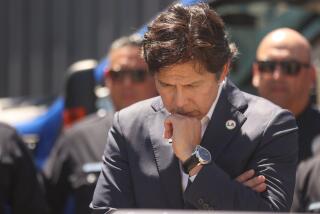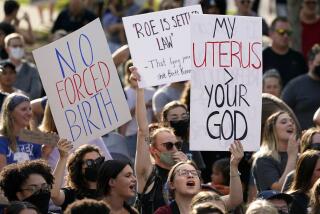Candidates Approach Iowa Spending Cap
WASHINGTON — In what has become a quadrennial ritual, presidential hopefuls--this time led by Rep. Richard A. Gephardt (D-Mo.)--are flirting with violating federal law by spending more money in Iowa than campaign finance rules allow.
Federal law bars candidates from spending more than about $775,000 in Iowa. But because Iowa’s first-in-the-nation presidential caucuses, to be held Monday, have disproportionate importance in the long campaign, candidates routinely violate that rule.
Gephardt is the candidate most likely to go over the Iowa limit, Federal Election Commission filings indicate, although others, including Democrats Paul Simon and Michael S. Dukakis and Republicans George Bush and Bob Dole, are also close to the cap.
According to his latest financial report filed with the FEC, Gephardt spent $494,175.11 in Iowa through Dec. 31. Since then, according to a survey by The Times, advertisements costing at least an additional $279,980 have appeared on regional television stations.
Field Expenses Additional
That would bring Gephardt’s total Iowa spending to $774,155 without considering the cost of his Iowa field operation--the salaries for the roughly 120 paid campaign staff he has in the state, rental for his campaign headquarters, his own travel and expenses and the expected massive get-out-the-vote drive that his supporters plan for Monday.
Robert Bauer, the Gephardt campaign’s lawyer, says he is confident that “from my point of view, we’ll be under the cap.” But he concedes, “I have to tell you I have no control over the vagaries” of the FEC’s view of the matter.
More than $100,000 of Gephardt’s 1988 television spending was paid for in December and has already been included in the $494,000 reported to the FEC, Bauer said, in arguing that the campaign has abided by the limit.
Because of the cost of field operations, however, even deducting that amount would not appear to be enough to keep Gephardt under the limit. Democratic campaign officials estimate that field operations from Jan. 1 until the Feb. 8 caucuses will cost each of the candidates at least $200,000 to $300,000 that must be charged against their Iowa ceilings.
Bush, Dole, Simon, Dukakis and former Arizona Gov. Bruce Babbitt all reported spending between $450,000 and $490,000 in Iowa during 1987, suggesting that the advertising and field operations they are now using could push any one of them over the limit.
The state-by-state spending ceilings, calculated at about 16 cents per voter, are designed to prevent better-financed campaigns from swamping their rivals in key contests. Much like a speed limit, the caps do succeed in restraining spending, but at the same time, they are often violated. In fact, breaking the ceiling, particularly in Iowa, has become a campaign tradition.
Mondale Tops Limit
In 1984, for example, Walter F. Mondale overspent in Iowa by $147,000. He also broke the limit in New Hampshire and Maine and exceeded the national spending cap. Mondale’s campaign eventually paid $726,000 in fines and penalties.
Ronald Reagan overspent in New Hampshire in 1976. In 1980 Reagan, Jimmy Carter, Sen. Edward M. Kennedy (D-Mass.) and political extremist Lyndon H. LaRouche Jr. all broke the New Hampshire ceiling, and both Carter and Kennedy overspent in Iowa.
Under the law, a campaign that exceeds the limit must return to the government the excess spending that was done with federal matching funds. If, for example, 35% of a campaign’s revenue is matching funds, 35% of any overspending has to be returned to the Treasury. In addition, the FEC can levy a fine.
But while the penalties can be expensive, they pale against the threat of losing a key contest, and so the incentive to break the rules is powerful. Within the FEC’s complex rules, the possibilities for arguing about the limit are endless.
It is a burden that the FEC, itself, is on record as opposing. Since 1980, the commission has asked Congress to repeal the state ceiling rule and end the detailed paper work now required to show how campaigns allocate their spending.
Television Spending Detailed
Some idea of the complexity of the rules can be gleaned by looking at how television spending--the largest single item in most campaign budgets--is accounted for.
If, for example, a candidate buys $36,000 worth of time on KCAU in Sioux City, Iowa, as Gephardt did last month, 68% of that money is charged to his Iowa budget. The remainder can be charged against the spending caps for Kansas and Nebraska, where some of the station’s viewers live.
The same rule allows campaigns to buy time on Boston television--watched by most New Hampshire voters--and charge the bulk of the cost against the Massachusetts spending limit.
That’s not all. If a campaign includes a tag line at the end of an advertisement asking viewers to send in a donation, something both Gephardt and Dukakis have done, part of the cost can be charged off as a fund-raising expense, which is not part of the state-by-state limit. How much of the cost can be deducted remains highly unclear.
Similarly complex rules govern such mundane items as air fare and lodging. If a candidate or an aide spends more than four consecutive days in a state, his or her salary and expenses count against the state ceiling. But if the person leaves, even overnight, the trip can be charged against national, rather than state, spending.
The rule helps account for some of the frenetic nature of campaign scheduling. All the candidates are trying to spend as much time as possible in Iowa, but Dukakis, for example, plans to spend today across the state line in Minnesota, South Dakota and Nebraska.
Even calculating the state limits is complicated. The formula includes an annual cost-of-living increase and because the Labor Department has not officially certified last year’s inflation rate, the FEC cannot say definitely what each state’s cap now is. However, applying that inflation rate--which has already been announced--to the previous year’s cap has allowed campaigns to estimate the limit for Iowa at $775,000.
Several campaigns have taken other steps to keep spending under the limit. Most of Dukakis’ Iowa staff took a pay cut recently to reduce his expenses, for example, and many campaigns routinely rent cars outside Iowa in attempts to keep those costs off the state budget.
Staff writers Robert Gillette and Marlene Cimons contributed to this story.
More to Read
Get the L.A. Times Politics newsletter
Deeply reported insights into legislation, politics and policy from Sacramento, Washington and beyond. In your inbox three times per week.
You may occasionally receive promotional content from the Los Angeles Times.











